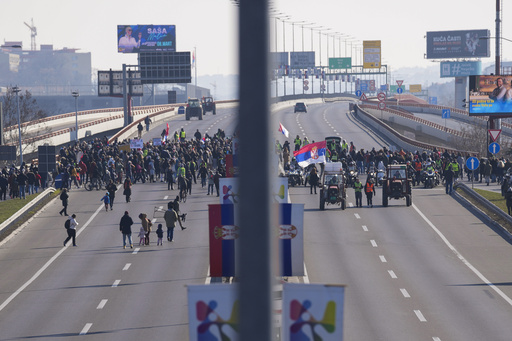BELGRADE, Serbia — University students on strike in Serbia organized significant protests on Sunday, blocking a major bridge in Belgrade and several roads across the country. These actions were a commemoration of the tragic incident that occurred 100 days prior when a concrete canopy at a train station collapsed, resulting in the deaths of 15 individuals.
Numerous locals joined the students for a seven-hour blockade of the Gazela bridge, which spans the Sava River in the capital. Concurrently, a three-hour shutdown of important roads occurred in Novi Sad, while students in Niš obstructed traffic at a highway toll station located at the city’s southern entrance.
These protests are part of a broader movement initiated by the university students, who are seeking accountability in relation to the Nov. 1 disaster in Novi Sad. Protesters and critics have attributed the catastrophe to government corruption. One protest site in Novi Sad featured a message scrawled in crimson paint proclaiming, “In 100 days, no one is accountable.”
The demonstrations, initially focused on anti-corruption, are evolving into a national movement opposing the populist regime of the authoritarian President Aleksandar Vu?i?. He has accused the demonstrators of being agents of foreign intelligence and vowed to resist what he termed a “colored revolution” intended to unseat him. The student-led protests have already led to the resignation of Prime Minister Miloš Vu?evi?, who was an ally of Vu?i?.
The canopy collapse has emerged as a pivotal symbol in the fight for democracy against Vu?i?’s administration. In recent weeks, tens of thousands have participated in nearly daily protests and blockades. As protesters arrived at the Gazela bridge, they carried red banners inscribed with the names of the deceased from November 1. Later, they dropped 15 red-painted white roses into the Sava River, symbolizing what they refer to as the “blood on the hands” of the ruling authorities.
“There is hope,” stated Ivan Ple?i?, one of the demonstrators. “A new movement is awakening; we can see fresh strength and energy among the people. I hope they will achieve everything they intend, and we are here to support them.”
In response, Vu?i? has embarked on a propaganda campaign, rallying his supporters throughout various towns and villages to counter the protests. During a motorcade on Saturday, his vehicle experienced a tire blowout, which pro-government tabloids and officials have characterized as an assassination attempt by protesters.
Since taking power over a decade ago, Vu?i? and his Serbian Progressive Party have systematically tightened their grip on state institutions and mainstream media, framing any opposition as a foreign-led initiative aimed at destabilizing Serbia.
On Sunday, a cohort of students began a run from Kragujevac, the central town, towards Belgrade to distribute invitations for a rally planned for February 15, coinciding with Serbia’s national statehood holiday. Vu?i? has also slated a rally for the same date in Novi Sad.
The protests resonate deeply in a Serbia plagued by corruption, where numerous citizens doubt that state institutions serve public interests. Many attribute the canopy collapse to corruption within government dealings associated with a significant infrastructure project linked to Chinese state corporations.



